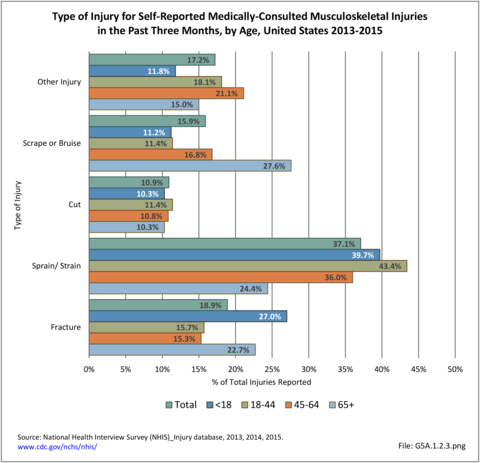 [10]
[10] 

The type of self-reported injury reported showed small variations by demographic group, particularly with respect to age and race/ethnicity. Overall, the most common type of musculoskeletal injury for which medical attention was sought was a sprain or strain (37%). This was particularly true for non-Hispanic blacks (42%) and non-Hispanic others (43%), and persons age 18 to 44 (43%). Persons age 65 and older were most likely to report a scrape or bruise (contusion) for which they sought medical attention (28%). Fractures were most common among those 18 and younger (27%). (Reference Table 5A.3.1 PDF [1] CSV [2]; Table 5A.3.2 PDF [3] CSV [4]; Table 5A.3.3 PDF [5] CSV [6]; Table 5A.3.4 PDF [7] CSV [8])
Injuries to the lower extremity were the most common injury site, accounting for 45% of all musculoskeletal injuries for which medical attention was sought. Female individuals reported lower extremity injuries more than male (52% and 39% of all injuries, respectively) while 42% of injuries reported by male individuals were to the upper extremity. Persons age 18 to 64 years were most likely to have a back injury, but injuries to the neck/back/spine accounted for only 13% of reported injuries. Spine injuries were reported in the West region (19%) more than other regions. Race/ethnicity was not a factor is anatomic site of injuries for which medical attention was sought. (Reference Table 5A.3.1 PDF [1] CSV [2]; Table 5A.3.2 PDF [3] CSV [4]; Table 5A.3.3 PDF [5] CSV [6]; Table 5A.3.4 PDF [7] CSV [8])
Sprains and strains accounted for 64% of injuries for which medical attention was sought when the neck/back/spine were involved, and 41% of lower extremity injuries. Scrapes and bruises accounted to 49% of torso injuries. Injuries to the upper extremity were distributed across all types of injuries. Fractures occurred more frequently from a fall, while sprains and strains were more common with vehicle or sport-related injuries. Cuts and other types of injuries occurred from other causes. (Reference Table 5A.4.1 PDF [13] CSV [14]; Table 5A.4.2 PDF [15] CSV [16])
Just over 6% of self-reported medically-consulted musculoskeletal injuries resulted in hospitalization of one night or longer. Fractures were most likely to result in hospitalization (16%), with sprains and strains least likely (2%). Injuries to the torso were more likely to result in hospitalization (10%) than injuries to other anatomic sites. Injuries resulting from falls (10%) also had a greater likelihood of hospitalization. (Reference Table 5A.4.3 PDF [19] CSV [20])
Links:
[1] https://bmus.latticegroup.com/docs/bmus_4e_5a.3.1.pdf
[2] https://bmus.latticegroup.com/docs/bmus_4e_5a.3.1.csv
[3] https://bmus.latticegroup.com/docs/bmus_4e_5a.3.2.pdf
[4] https://bmus.latticegroup.com/docs/bmus_4e_5a.3.2.csv
[5] https://bmus.latticegroup.com/docs/bmus_4e_5a.3.3.pdf
[6] https://bmus.latticegroup.com/docs/bmus_4e_5a.3.3.csv
[7] https://bmus.latticegroup.com/docs/bmus_4e_5a.3.4.pdf
[8] https://bmus.latticegroup.com/docs/bmus_4e_5a.3.4.csv
[9] https://bmus.latticegroup.com/file/bmuse4g5a123png
[10] https://bmus.latticegroup.com/docs/bmus_e4_g5a.1.2.3.png
[11] https://bmus.latticegroup.com/file/bmuse4g5a124png
[12] https://bmus.latticegroup.com/docs/bmus_e4_g5a.1.2.4.png
[13] https://bmus.latticegroup.com/docs/bmus_4e_5a.4.1.pdf
[14] https://bmus.latticegroup.com/docs/bmus_4e_5a.4.1.csv
[15] https://bmus.latticegroup.com/docs/bmus_4e_5a.4.2.pdf
[16] https://bmus.latticegroup.com/docs/bmus_4e_5a.4.2.csv
[17] https://bmus.latticegroup.com/file/bmuse4g5a125png
[18] https://bmus.latticegroup.com/docs/bmus_e4_g5a.1.2.5.png
[19] https://bmus.latticegroup.com/docs/bmus_4e_5a.4.3.pdf
[20] https://bmus.latticegroup.com/docs/bmus_4e_5a.4.3.csv